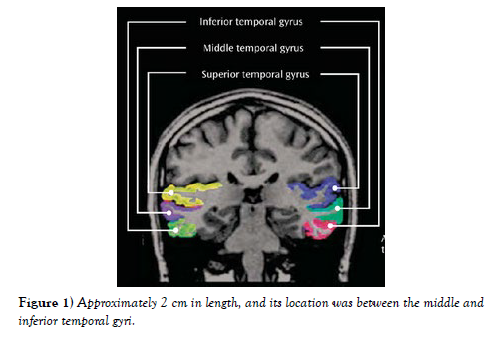A Rare Anomaly of the Human Brain: Case Report of a Unique Neuroanatomy
Received: 24-Mar-2023, Manuscript No. ijav-23-6232; Editor assigned: 27-Mar-2023, Pre QC No. ijav-23-6232 (PQ); Accepted Date: Apr 14, 2023; Reviewed: 10-Apr-2023 QC No. ijav-23-6232; Revised: 14-Apr-2023, Manuscript No. ijav-23-6232 (R); Published: 21-Apr-2023, DOI: 10.37532/1308-4038.16(4).254
Citation: Karl M. A Rare Anomaly of the Human Brain: Case Report of a Unique Neuroanatomy. Int J Anat Var. 2023;16(4):283-283.
This open-access article is distributed under the terms of the Creative Commons Attribution Non-Commercial License (CC BY-NC) (http://creativecommons.org/licenses/by-nc/4.0/), which permits reuse, distribution and reproduction of the article, provided that the original work is properly cited and the reuse is restricted to noncommercial purposes. For commercial reuse, contact reprints@pulsus.com
Abstract
The human brain is a complex and intricate organ, and variations in its anatomy are not uncommon. Here, we present a case of a rare anomaly of the human brain observed during a routine autopsy. The anomaly was a unique variation in the neuroanatomy of the brain, which involved the presence of an additional gyrus in the temporal lobe. We describe the details of this case, including the location of the anomaly, its size and shape, and its relation to surrounding brain structures. This case report highlights the importance of understanding the variability in the human brain’s anatomy, and the potential impact on the function of the brain.
Keywords
Neuroanatomy; Brain; Gyrus; Parahippocampal gyrus
INTRODUCTION
The study of neuroanatomy is crucial in understanding the normal function of the human brain and its various pathologies. The human brain is a complex organ with a multitude of structures and connections, which vary in size, shape, and function [1]. While there is a general consensus on the basic structure and organization of the human brain, variations in its anatomy are not uncommon. These variations can range from minor differences in the size and shape of brain structures to more significant anomalies involving the absence or presence of additional structures [2-3]. Here, we present a case of a rare anomaly of the human brain, which highlights the importance of understanding the variability of the human brain’s anatomy [4].
CASE REPORT
A routine autopsy was performed on a 67-year-old male who had died of natural causes. During the autopsy, an additional gyrus was observed in the right temporal lobe of the brain. The gyrus was approximately 2 cm in length, and its location was between the middle and inferior temporal gyri. The additional gyrus was not present in the left temporal lobe or any other regions of the brain [5] [Figure 1].
Further examination of the brain revealed that the additional gyrus was connected to the surrounding brain structures, including the hippocampus and the parahippocampal gyrus. The size and shape of the additional gyrus were consistent with the surrounding gyri, suggesting that it had developed in utero and was not a result of postnatal growth or injury [6-7].
CONCLUSION
In conclusion, we report a rare anomaly of the human brain, which involved the presence of an additional gyrus in the temporal lobe. The anomaly was unique, and to the best of our knowledge, has not been previously reported in the literature. This case highlights the importance of understanding the variability of the human brain’s anatomy and its potential impact on brain function. Further research is needed to investigate the functional significance of this anomaly and its relation to other brain structures.
ACKNOWLEDGEMENT:
None.
CONFLICTS OF INTEREST:
None.
REFERENCES
- Kuo-Shyang J, Shu-Sheng L, Chiung-FC. The Role of Endoglin in Hepatocellular Carcinoma. Int J Mol Sci. 2021; 22(6):3208.
- Anri S, Masayoshi O, Shigeru H. Glomerular Neovascularization in Nondiabetic Renal Allograft Is Associated with Calcineurin Inhibitor Toxicity. Nephron. 2020; 144 Suppl 1:37-42.
- Mamikonyan VR, Pivin EA, Krakhmaleva DA. Mechanisms of corneal neovascularization and modern options for its suppression. Vestn Oftalmo. 2016; 132(4):81-87.
- Brian M, Jared PB, Laura E. Thoracic surgery milestones 2.0: Rationale and revision. J Thorac Cardiovasc Surg. 2020 Nov; 160(5):1399-1404.
- Amy LH, Shari LM. Obtaining Meaningful Assessment in Thoracic Surgery Education . Thorac Surg Clin. 2019 Aug;29(3):239-247.
- Farid MS, Kristin W, Gilles B. The History and Evolution of Surgical Instruments in Thoracic Surgery. Thorac Surg Clin. 2021 Nov; 31 (4): 449- 461.
- John C, Christian J. Commentary: Thoracic surgery residency: Not a spectator sport. J Thorac Cardiovasc Surg. 2020 Jun; 159(6):2345-2346.
Indexed at, Google Scholar, Crossref
Indexed at, Google Scholar, Crossref
Indexed at, Google Scholar, Crossref
Indexed at, Google Scholar, Crossref
Indexed at, Google Scholar, Crossref
Indexed at, Google Scholar, Crossref







